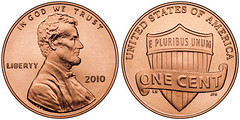
PREV ARTICLE
NEXT ARTICLE
FULL ISSUE
PREV FULL ISSUE
PUBLIC BEGINS REACTING TO NEW SHIELD CENT DESIGN
Wednesday's Washington Post included an article about last year's new Shield design on the reverse of the Lincoln Cent. Included on the article web page is a video with interviews with tourists visiting the Lincoln Memorial, which was displaced from the cent reverse after a 50-year reign (1958-2008). Many people are only now beginning to see the coin in daily commerce. I saw few examples in change myself until just this month, when they started to become more prevalent.
-Editor


You may have noticed a small change in your small change. More likely, you haven't. "Now when did they do that?" asked Victor Schubert, a lawyer from Racine, Wis., squinting at a freshly minted 2010 penny. "And why?" Schubert and other tourists on the steps of the Lincoln Memorial one recent afternoon were surprised to see a brand-new look to that most familiar of coins. Gone from the Lincoln penny is the reproduction of the Lincoln Memorial, complete with really tiny seated Lincoln, that has been "tails" since 1959. In its place is a "Union Shield," a simple acorn of 13 stripes capped with the motto "E Pluribus Unum." On the "heads" side, the iconic profile of the 16th president by Victor David Brenner remains unchanged. The U.S. Mint has been stamping out the new design since February; presses in Philadelphia and Denver have produced more than 3.6 billion of them. But officials said the down economy has made banks slow to request new coins. It will be years, they said, before shield pennies become as common as the tens of billions of Lincoln Memorial pennies filling sofa cracks and dresser tops across the country. Mint spokesman Michael White said there have been few comments from the public about the new design, probably because few have spotted it. "It's a phenomenon of notice - once you see one, they're everywhere," White said. "But you don't tend to examine your change unless you're a coin collector." Most visitors to the Lincoln Memorial - where a huge mock-up of the old penny adorns the entrance to an exhibit hall - said they were sorry to see the memorial end its half-century run as the most common edifice in American pockets. "This building has a lot of meaning for me," said Schubert, 73, who first came to Washington on a high school trip. Whenever he's here, he still makes time to walk up the steps to see the giant Lincoln. "I stood right by that column on the corner and looked out over this beautiful expanse and decided I wanted to become a lawyer. I'll miss seeing it on the penny." Then Schubert paused to consider the scale of the change, literally. "Not that I look at pennies very much anyway," he said. Janey Hockenhull, chaperoning a group of fifth-graders from Fort Lauderdale, Fla., said she doesn't like to see perfectly good coins get the flip, as it were. "If something doesn't need changing, don't change it," she said. "What was wrong with the old penny?" Nothing, Mint officials said, but that didn't stop Congress from demanding a new one, as it has about every 50 years since the Lincoln penny was introduced in 1909 to mark the centennial of the great man's birth. Just as that first design, with ears of wheat framing the reverse side, gave way to the Lincoln Memorial penny in 1959, lawmakers directed the Mint to update the coin again this year. (For Lincoln's actual bicentennial year, 2009, the Mint released four commemorative pennies depicting different phases of his life.) "It really hasn't made much of a ripple this time except in coin circles," said Douglas Mudd, curator of the American Numismatic Association's Money Museum in Colorado Springs. "I think it was a bigger deal when the wheat penny went away. Some people got very worked up about that one." Part of the reason the new penny has dropped without much reaction may be a general new-coin fatigue, Mudd said. After decades when almost nothing on U.S. coins changed except the year they were minted, the past 10 years have seen almost every coin get a makeover. Gary Marks, chairman of the Citizens Coinage Advisory Committee, a congressionally appointed body, pushed for the Union Shield, which he said was quite popular during the Civil War, appearing on frescoes in the Capitol and carved into a lot of public marble around town. "It was on beer mugs, furniture," Marks said. "For Americans of the time, the Union Shield was broadly seen as a symbol of national unity." Mark's commission selected the shield design from among several proposals, and the Treasury adopted it. You can find the minuscule initials of designer Lyndall Bass and engraver Joseph Menna flanking the shield. Marks, who has a day job as the city administrator of Ketchum, Idaho, prefers more abstract symbols. "A building is a building," he said. "It's a cherished memorial, certainly, but on a coin, I think we're better served reaching for those iconic, artistic images that communicate our national values. To me, the Union Shield does that."
To read the complete article, see:
The Mint coins a new phase: After 50 years, Lincoln Memorial gone from the penny
(www.washingtonpost.com/wp-dyn/content/article The Numismatic Bibliomania Society is a non-profit organization promoting numismatic literature. See our web site at coinbooks.org. To submit items for publication in The E-Sylum, write to the Editor at this address: whomren@gmail.com To subscribe go to: https://my.binhost.com/lists/listinfo/esylum All Rights Reserved. NBS Home Page Contact the NBS webmaster 
|